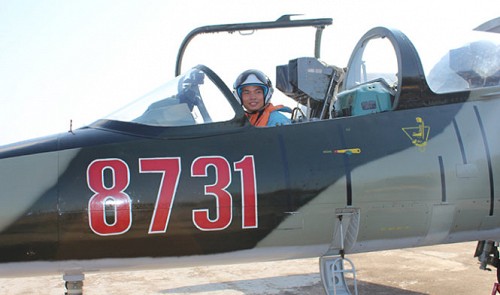The Nha Trang Air Force Academy in south-central Vietnam has been in charge of training combat pilots for the national air force since 1990.
At the special training facility, the classroom is the sky and the learning tool is the plane.
At 4:30 am one day, the camp of Air Regiment 910 at the academy was busy. Trainers, trainees, technicians and staff of the army ordnance were leaving for the nearby airport.
Trainees were queuing for health checks, including blood pressure readings, to ensure that they were eligible for flight.
At 5:30 am, a report from a meteorological scout plane confirmed that the weather conditions were good for training flights, and Colonel Duong Hong Truong, head of Air Regiment 910, gave the signal to start the training session.
The first plane taxied toward the runway, accelerated and took off into the sky.
Trainees practiced flying in circles, air and ground attacks, and flying through clouds under the instruction of trainers based on information from the control tower.
“It is the most scary to lose contact with the ground, and it is even more cruel when you suffer it in combat.
“The electronic radio system acts as a guide for pilots in the sky,” said Colonel Tran Ha Lan, deputy political commissar of the school.
Each flying lesson for a trainee lasts from 50 to 60 minutes within a radius of 73km, and the trainee has two to three sessions per day.
Air Regiment 910 covers the last training stage before a trainee becomes a combat pilot.
A trainee spends the first two years studying basic theory. The third year is for practicing with the Yak-52, a Soviet primary trainer aircraft for both civilian sport pilots and military captain.
Since the early 1990s, hundreds of Yak-52 aircraft have been exported to the west, and many Yak-52 planes are now flying in the U.S., the UK, New Zealand, Australia and other Western countries.
In the fourth and last year at the Nha Trang Air Force Academy, trainees learn on either the L-39, a high performance jet trainer aircraft for advanced pilot training developed in the former Czechoslovakia; or the Mi-8, a Soviet-designed medium-size twin turbine transport helicopter.
Returning after a lesson in the sky, Sergeant Major and trainee Hoang Viet Thai said he would never forget the feeling after he completed his debut flight without a trainer.
He said he told himself after this flight that he had nearly reached the dream of becoming a military pilot.
Harsh selection
The trainees who are selected to fly the L-39 during their training course are outstanding men.
They passed all the harsh selection tests and are qualified for flying with any state-of-the-art warplane.
“Only a third of the trainees at the start of a training program are qualified to fly military aircraft,” said Major Nguyen Minh Nhat, deputy political commissar of Air Regiment 910.
A combat pilot is able to make hundreds of complicated flying maneuvers, such as aerial acrobatics, nosedives, fast ascents and flying in a twisting line.
He must not only be healthy but also strong when it comes to spinning.
A strong pilot is able to walk firmly after sitting in a fast-turning Ferris wheel for several minutes, or sitting in a chair turning around for a while.
This strength helps pilots be able to make complicated moves thousands of meters in the sky.
Some trainees had to be moved to other disciplines of the school because they were unable to control a Yak-52 even though they had gone through two years of basic theory, said Colonel Pham Van Dong.
Others succeeded in flying the Yak-52 but failed on the L-39, and were thus moved to train to fly the Mi-8 helicopter.
A combat pilot is also mentally firm in the face of sudden technical troubles or other challenges in the sky.
Before 1990, Vietnam had to send pilots to train in Russia or Australia, but now, the Nha Trang Air Force Academy is capable of helping train pilots for even the air forces of Laos and Cambodia.

























































